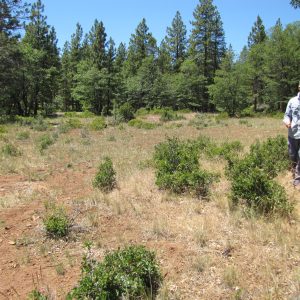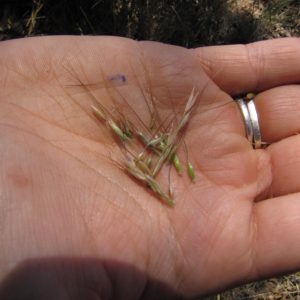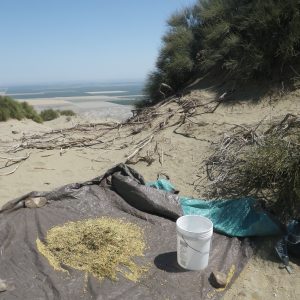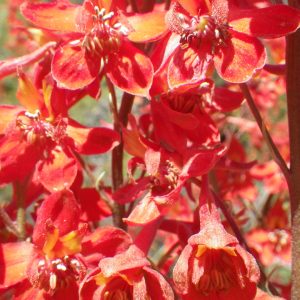This last weekend I had the opportunity to go to the Montana Native Plant Society Annual Meeting in Missoula, MT. The drive was long, but it was worth it. I was able to meet a lot of great botanists, who did all that they could to help me learn some new plants (and since I am originally from Iowa, the number of plants that I didn’t know out numbered the ones I did). I was even able to meet the author of the newly published Manual of Montana Flora, which will be our new go-to field guide. On Saturday, I went on a fieldtrip to the Garnet Ghost Town, which involved botany stops along the way to look at what plants were present, and then a tour of the ghost town. Overall, the group saw 131 different plant species within just a few yards of the road. My favorite plant that we saw had to be the bear grass (although the lady slipper is a close second).
Daily Archives: 3 July, 2012
Work and Workshop! Krista Butler- Ridgecrest BLM
As a part of the CLM Internship program, there is a week long workshop we can attend as a part of our training. This year, we were at the Chicago Botanic Garden and it was spectacular! The workshop kept us busy all day, so many informative sessions covering a wide range of important topics to our jobs. We had classes focusing on plant identification, conservation genetics, monitoring techniques, wildlife conservation, the different federal agencies, and more! It was a beautiful setting, in eco-friendly buildings on a lush campus. It was very rewarding to meet Krissa and Marian, the people running our program, and a good number of the other interns from all over the country.
I have been able to finally begin some seed collecting in the Ridgecrest Field Office area. It’s been a very dry year, so the only plants producing seed in large enough quantities to collect enough seeds for the Seeds of Success program, are some of the larger annual shrubs. I’ve been working on collections for Salazaria mexicana (paper bag bush), Cleome isomeris (bladderpod), and will soon be starting on Larrea tridentata (creosote bush). It’s been interesting to see first hand how what seem like minor differences in climate regimes can make huge differences in the reproductive capabilities of a species for a season. One collection I made of bladderpods is significantly more impressive and valuable than the first collection I made, largely due to their location differences.
I recently had the opportunity to go into the field with my mentor, a wildlife biologist, to assist in the surveying of abandoned mines for bat and other wildlife habitat. Our area experienced a large mining boom during the late 1800s to 1900s, resulting in a lot of exploration. Now that the area is more populated, thus more recreational users and monitoring of the vegetation and wildlife, there is greater concern over the status of these abandoned mining features. We assessed an area with many known abandoned mining shafts, addits, trenches, and other exploratory features to determine which needed to be permanently closed, and if so, what methods would be best suited for the closing.

And here’s a picture of some of us interns at the Bean in downtown Chicago!

The Importance of Phlox
During the past month out here at the Alturas BLM field office I have had the opportunity to travel quite a bit. My field partner Jaycee and I headed up to Lava Beds National Monument in early June for a work week. We stayed at the research station there because it is much closer to some BLM land near the Oregon border, and we were able to save several hours of driving each day. We were also able to participate with some Park Service projects. This included attending a plant phenology and climate change class. Some folks out of UC Santa Barbara have set up a plant phenology monitoring network for California and they want the National Park Service to get on board. This mainly involves training citizen scientists to go out and make observations about plants throughout the year. The date of major phonological stages such as bud break, flowering, and fruit maturation are recorded on a website. This data is taken from a wide geographic range, the goal being to determine if these phenological stages are occurring sooner due to changing climate. We were also able help out with some fire effects monitoring with NPS employees. We ran transects in an area where they had done a prescribed burn nine years previously. In a five by thirty meter area we found thirty two species of plants, which seems like pretty good evidence that fire is necessary for biodiversity. After that we climbed Mount Dome, a very steep cinder cone, in search of a rare species of rice grass. We thought we found it, but later learned we were mistaken, proving that the desire to find what we are looking for often clouds our better judgment. Or maybe we were distracted by the view and falcons circling us.
The next week was the workshop at the Chicago Botanic Garden. This was a whirlwind of long days of learning about myriad topics related to what we are doing. It was great to get a better picture of what the Conservation and Land Management program is all about, as well as to meet interns who are working all around the country. I guess I’m not the only one sticking out like a sore thumb in some remote Western cowboy town that nobody has ever heard of.
Lately we started collecting our first seed. We successfully collected seeds of two species of grass. We had also previously identified a phlox and a lily as good targets due to their abundance, but the phlox had already set seed and the lily seemed to have been scorched off the face of the planet since the weather heated up. This goes to show that seed collection requires vigilant observation, or else the seeding window can be missed. This was, to be honest, somewhat of a relief. Spring was nothing but excitement as we tromped around, making note of all the pretty flowers that would be cool to collect later. It didn’t even occur to us how immense a task collecting 10,000 phlox seeds would be, given that each phlox flower only produces one seed, a proper collection only takes 20% of the available seed of a population, and phlox can be painfully spiny.
Speaking of phlox, we also went to the Modoc Gulch to survey for a rare species, Phlox muscoides. We looked both in areas where juniper cuts are going to take place, and in areas where it was previously found and pretty much didn’t find it in either. It was good that we didn’t find any of this phlox in the juniper cut areas, as this means it won’t be disturbed. As for the sites where it is already known to occur, it was frustrating to drive several hours to and from these sites and not even find it. However, today I was able to do a little detective work which helped me feel significantly less useless. I filled out data forms for what we had found, or not found, for the California Natural Diversity Database (run by California Department of Fish and Game). I found the phlox entry that we had looked for, and learned that the last time it was documented was probably at least fifteen years ago. In that light it is not surprising at all that we didn’t find it, as the juniper and mountain mahogany trees have no doubt grown and shaded out many plants in that amount of time. Other factors could be at play here, such as overgrazing by wild horses (there is ample evidence of them at Modoc Gulch). I realized that it is monitoring like this that is necessary to determine changes in biodiversity, as well as the efficacy of actions that the BLM takes, such as juniper and wild horse removal. How will the ecosystem change after they are removed? Are we unnecessarily altering a natural ebb and flow of plant communities, or are we improving biodiversity?
Joe Broberg
Alturas BLM Field Office
The Wild and Wonderful Arizona
They said Phoenix would be hot; I didn’t believe them. They said the snakes are poisonous, the scorpion’s sting burns like you wouldn’t believe and the cholla cacti spines will actually jump off the plant and stick your leg like some moisture-seeking missile as you walk by. What they said was true; Arizona is a very different place from my native Wisconsin where the Holstein cows rein supreme, where the pastures are lush due to the dark, fertile mollisols created by hundreds of years of dominance by native tall- and short-grass prairies and where the number of plants with spines pales in comparison to the number of friendly leafy ones.
What they neglected to mention, however, whether due to a blunting of appreciation caused by day after scorching day spent on the rangelands or otherwise, where the wondrous vistas afforded by the vast mesas surrounded by sentinel-like mountain ranges whose looming presence is suggestive of bodyguards, the brilliant canvas of colors that the sun throws towards the heavens in a last grasp for glory before he is extinguished for the night which contrast with the leathery black silhouettes of the peaks and canyons, and the sheer authority and erudition that the noble saguaro cacti command through the valleys and across the plains.
My two weeks working at the Bureau of Land Management in Phoenix have been short but very impressionable so far and I can’t wait to see what is waiting just over the horizon.
the abundant and the scarce
 The Carrizo Plain, one of our most visited sites, is turning many pretty shades of brown right now as everything dries out.
The Carrizo Plain, one of our most visited sites, is turning many pretty shades of brown right now as everything dries out.
As our season here winds down (wow, I can hardly believe there are only a couple months left!) Rachel and I have been focusing more intensely on a few late-seeding plants. One of the plants in full bloom right now is Eriogonum fasciculatum var. polifolium, or California buckwheat. Although the USDA plants profile lists this species as “Eastern Mojave buckwheat,” it grows readily in sites within the Bakersfield Field Office boundaries. This shrub has pretty white flowers that fade to red, then brown and orange as the seeds dry. This is a fairly common plant that grows abundantly along roadsides, so we are happy to have a good number of sources. Here is a picture of Rachel collecting seed at a site near Lake Isabella, CA.
A less common plant that we colleced recently was Isomeris arborea, also called Bladder Pod. According to the seeds of success webpage, it hasn’t yet been collected.
It’s almost a dream: Colorado
I am the new CLM intern in Lakewood, Colorado for the Bureau of Land Management (BLM) at the Colorado State Office. I started with the BLM on June 11th and so far it has been amazing. After only having a month to transition from recent college graduate in Georgia to new CLM intern in Colorado, I do believe that I have settled in quite nicely here. Everyone has been more than willing to help me smoothly adjust to my new community (if that be joining a local kickball league in Denver or planning trips to search for treasures at the local thrift store). This friendly and caring spirit is something I like to call “Western Hospitality.” I am grateful to have such wonderful coworkers, mentors, neighbors, and community members. I am really looking forward to enjoying my time here.
Over the next coming months of my internship, I will be scouting and monitoring new sites for populations of flowering and fruiting plants that can be used for Seeds of Success (S.O.S). Also, surveying and GPS/GIS mapping old locations by monitoring the conditions of past identified plant populations planned for seed collection, such as Thermopsis divaricarpa (my favorite plant species at the moment). Our SOS goal will be to identify about twenty-five plant species populations for seed collection, which we hope will not be too difficult – despite the forest fires.
Spending a week at the Chicago Botanic Garden for the CLM Workshop was an educational and fun experience. I met many interns that share my same passion for wildlife. I am sure that I will stay in contact with the friends that I have made even after the program.
It’s always a great feeling to be in the field identifying various flowers. In the distance, I notice hikers and bikers who probably had to take the day off from work to enjoy their own “backyard.” Then, I suddenly remember that I did not have to take a vacation day or a personal day to be out in the foothills. I’m enjoying what so many people wish they could experience on a daily basis rather than just on the occasionally family vacation. I feel very fortunate. Being able to travel to parks and forests to observe plants for SOS and take in the opulent magnificence of Colorado’s mountains is incredible – and to think I’m getting paid to do this!
It is hard to not be in awe by these beautiful mountains and hills surrounding Lakewood. Few plants can grow in such harsh, varying conditions of extreme, dry and hot summers to bitter, cold winters. These plants must be resilient in order to survive. At Mount Galbraith (~7,200 feet elevation!), we were scouting to identify new plant populations and came upon a small herd of deer with a fawn looking very curious. Closely, I noticed how frail one of deer appeared by the apparent outlining of its ribs. Looking around at the dry, black crackling ground and the thirsty brown grasses of the foothills (in a sudden sense of panic), I started to wonder how these animals and plants will survive such a harsh and almost unforgiving environment. As quickly as this thought began, I realized if these deer can endure and even thrive within the precarious ledges and cliffs stricken with its fair share of fires; then, I am sure wildlife throughout can survive as well. After all, its nature and nature has its ways of taking care of itself…
From the colorful mountains of Colorado, happy hiking folks…
Darnisha Coverson
Laramie, WY
It has been a busy week since arriving back in Laramie, Wyoming from the training session in Chicago, Illinois. I have been working in both the field and the lab. In the field my team and I have been making SOS collections. We are up to eleven collections so far. Our collections vary by site which makes every field day interesting. We go to the mountains in the Laramie Range and the Sierra Nevada Range in addition to the surrounding sage brush step. This past week we went up to Thunder Basin National grassland. It was hot and dry as it has been all summer long. It has been perfect condition for fires which have been burning all around the state. One of my team’s potential SOS collection sites got burned in a recent fire at Glendo State Park in Wyoming. However, it is not all field work for me. As I am stationed out of the University of Wyoming, I also get to participate in research. I have been plating seeds from last year’s SOS collections in agar for germination studies. I have to be very careful to keep all my tools sterilized in order to grow plants and not fungi. It has been exciting to see two sides of the SOS program; the seed collections and the research.
Learning in Carlsbad
Though I graduated more than a month ago, any notions of leaving education behind me have been swept away by my first few weeks on the job here at the BLM office in Carlsbad, New Mexico. This post’s word is LEARNING.
Just last week I joined sixty of my peers, summoned from the far corners of America’s public lands, for a training workshop at the Chicago Botanic Garden. I wondered what training there could be that would apply equally to me as to counterparts, say, on the Oregon coast, but the CBG delivered. I was grateful for a crash course in plant family ID, which formalized smidgens I have picked up in the field. It was also great to hear the history of the CLM program, but even better to hear why we matter. For me the week led up to the story of Sand Mountain, a BLM site east of Carson City where CLM interns’ grunt work was the foundation for an agreement to safeguard the Sand Mountain blue butterfly.
My Sand Mountain is the deep sand country east of Carlsbad, where the focus of my internship is an AIM study at 24 sites. My part in the Assessment, Inventory and Monitoring is a series of vegetation transects coupled with species richness surveys and soil stability tests. Transects are fun, especially the challenge of plant ID. It has been tough wrapping my brain around the conversion between the environments of western North Carolina and southeastern New Mexico. A smattering of what I’ve had to learn:
Oaks are: (NC) majestic giants reaching several stories above you. (NM) groundcover.
Grasses are: (NC) demure and wispy. (NM) some of the biggest, meanest, toughest plants around.
Don’t touch the plants, because: (NC) you could hurt them! (NM) they could hurt you!
Sandspurs are a painful problem: (NC) at the beach. (NM) everywhere.
Rain is: (NC) a refreshing end to a warm summer day. (NM) a rumor, nothing more.
Herpetologists study: (NC) huge salamanders. (NM) hugely controversial lizards.
Cows walking in the middle of the road are (NC) unheard of. (NM) typical field work day traffic.
Dead plant matter will (NC) promptly decompose into compost. (NM) sit there forever awaiting a fire.
Besides the AIM studies I’m being sent to lots of other range and wildlife projects around the office, wherever help is needed. We’ll see how it all goes and I’ll share in future posts.
June in Hollister
Most of this month has been spent collecting seed, and also finishing up the spring plant monitoring. I am including some pictures of collecting Ephedra (Mormon Tea) seed, of Delphinium cardinale on Laguna Mountain, and of a Common Poorwill whose nest we accidentally found while collecting seed. Finding cool birds is another advantage of being out in the field!
When we are not out in the field, I have been working on seed processing, and also on trying to learn ArcMap in order to map the new populations of rare and endangered plants that we located this spring. This is completely new for me and is challenging but interesting. I also used ArcMap to assist with preparing reports for parcels of land that will be up for sale later this year. My task was to report vegetation types and soil types. To report soil types, I used the old Soil Survey maps which I found very enjoyable. Another project I assisted with was helping the implementation crew clean up a target shooting area…wow what a lot of trash! $40 worth of scrap metal plus half a trailer of just trash. It has been interesting to see the way the public regards BLM lands. Of course, it varies a lot with the individual, but there seems to be a trend of people wanting the government to provide both access and free services on the BLM lands, but not wanting to take responsibilty that shared public ownership of the land entails. Of course this is neither new, nor suprising, and I have to keep in mind that there are people out there that appreciate having access to public lands and act responsibly so that everyone can enjoy them.
Next month we will be continuing the seed collection and in addition have a tamarisk removal project in Panoche Creek which should be interesting as the herbicide will be applied by helicopter…I’ll take pictures.
Almost one month in and its incredible how fast the time has flown by!! I am working in the great BLM state of Nevada. It has been an abrupt change from the lush landscape of Pennsylvania, but has been growing on me ever since I landed in Reno back in May. It’s great time getting to know my coworkers, mentor, and the ways of the Great Basin and Eastern Sierra’s. The most exciting, heart pounding, experience we have surmounted so far definitely has to be the face-to-face bear encounter one cold night up in the Sierra’s. Although slightly nerve racking it was amazing to see wildlife other then the occasional desert bird and lizard.
Recently, I have returned from the wonderful CBG workshop and can’t say enough how great it was to meet so many other interns like myself that are scattered across the nation. It definitely makes me feel like I am a part of a larger family then just the group of interns that I work with from the Carson City BLM office. The experience has made me feel proud to be a part of such an excellent program. I look forward to talking more about my botanical adventures in later posts and sharing the new stories that are bound to happen during my time in Nevada.



















